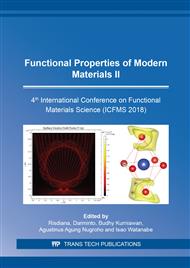p.373
p.378
p.386
p.392
p.398
p.404
p.409
p.415
p.422
Analysis of Defects and Surface Roughness on the Hydrogenated Amorphous Silicon (a-Si:H) Intrinsic Thin Film for Solar Cells
Abstract:
Effect of defect - through observation of energy absorption Urbach, on deposition rate, energy band gap, and surface roughness of intrinsic thin film are investigated using Radio Frequency Plasma Enhance Chemical Vapor Deposition (RF-PECVD). Films are grown on ITO (Indium Tin Oxide) glass substrate. Analysis of energy band gap is conducted to determine changes in the structure of a thin film of a-Si:H. Energy band gap is important to determine the portion of the spectrum of sunlight that is absorbed solar cells. From the characterization using UV-Vis spectrometer and the Tauc’s plot method, the width of the resulting energy band gap is greater if the hydrogen dilution is increased. It can be shown that the increase of the hydrogen dilution, will increase the energy band gap, and the surface roughness of thin layers. Instead, the improvement of the hydrogen dilution decrease the rate of deposition and Urbach energy. It is estimated that with greater hydrogen dilution, an intrinsic thin film of a-Si:H is more conductive for more reduction in residual of band tail defects or dangling bond defects.
Info:
Periodical:
Pages:
398-403
Citation:
Online since:
August 2019
Keywords:
Price:
Сopyright:
© 2019 Trans Tech Publications Ltd. All Rights Reserved
Share:
Citation:


